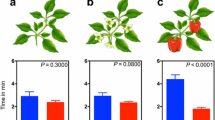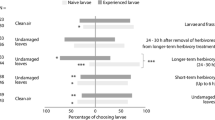Abstract
We investigated how chemical cues derived from female Asian citrus psyllid, Diaphorina citri Kuwayama (Hemiptera: Liviidae) and their host plants affect host acceptance choices by conspecifics. In four-choice cage and two-choice olfactometer assays, female psyllids avoided conspecific female cues in a density-dependent manner. However, odors from citrus plants actively damaged by psyllid feeding were attractive to conspecific females. When odors from feeding-damaged plants were presented simultaneously with odors from female D. citri, attraction of female conspecifics was no longer observed as compared with a clean air control in olfactometer assays. In subsequent experiments, D. citri females were released within arenas that contained actively feeding-damaged or non-damaged (control) citrus plants, each with previously psyllid-infested and uninfested young leaves. D. citri development is linked to the presence of these newly emerging leaves which is the only site of nymphal development. Female D. citri were initially attracted by the actively damaged plants as compared with non-damaged controls. After acceptance of plants that were actively damaged by feeding, D. citri females preferentially chose and settled on uninfested young leaves as compared with previously infested young leaves. A herbivore-induced plant volatile attractant and a female-specific odor repellent appear to be complementary foraging cues providing psyllids with information at two spatial scales: (1) the whole plant level for choosing a plant potentially harboring male conspecifics for mating, and (2) the within plant level to reduce intra-conspecific competition by identifying previously exploited resources.





Similar content being viewed by others
References
Bostock RM (2005) Signal crosstalk and induced resistance: straddling the line between cost and benefit. Annu Rev Phytopathol 43:545–580
Carroll MJ, Schmelz EA, Meagher RL, Teal PEA (2006) Attraction of Spodoptera frugiperda larvae to volatiles from herbivore-damaged maize seedlings. J Chem Ecol 32:1911–1924
Crawley JR (2009) The R book. Wiley, Chichester
Davis TS, Horton DR, Munyaneza JE, Landolt PJ (2012) Experimental infection of plants with an herbivore-associated bacterial endosymbiont influences herbivore host selection behavior. Plos One 7:e49330
Deisig N, Kropf J, Vitecek S, Pevergne D, Rouyar A, Sandoz J-C, Lucas P, Gadenne C, Anton S, Barrozo R (2012) Differential interactions of sex pheromone and plant odour in the olfactory pathway of a male moth. Plos One 7:e33159
Dicke M (2000) Chemical ecology of host-plant selection by herbivorous arthropods: a multitrophic perspective. Biochem Syst Ecol 28:601–617
Folimonova SY, Robertson CJ, Garnsey SM, Gowda S, Dawson WO (2009) Examination of the responses of different genotypes of citrus to Huanglongbing (citrus greening) under different conditions. Phytopathology 99:1346–1354
Grafton-Cardwell EE, Stelinski LL, Stansly PA (2013) Biology and management of Asian citrus psyllid, vector of the Huanglongbing pathogens. Annu Rev Entomol 58:413–432
Guedot C, Horton DR, Landolt PJ (2009a) Attraction of male winterform pear psylla to female-produced volatiles and to female extracts and evidence of male–male repellency. Entomol Exp Appl 13:191–197
Guedot C, Millar JG, Horton DR, Landolt PJ (2009b) Identification of a sex attractant pheromone for male winterform pear psylla, Cacopsylla pyricola. J Chem Ecol 35:1437–1447
Guedot C, Horton DR, Landolt PJ (2010) Sex attraction in Bactericera cockerelli (Hemiptera: Triozidae). Environ Entomol 39:1302–1308
Halbert SE (1998) Entomology section. Tri-ology 37:6–7
Halitschke R, Stenberg JA, Kessler D, Kessler A, Baldwin IT (2008) Shared signals—‘alarm calls’ from plants increase apparency to herbivores and their enemies in nature. Ecol Lett 11:24–34
Hall DG, Richardson ML, Ammar E-D, Halbert SE (2013) Asian citrus psyllid, Diaphorina citri, vector of citrus Huanglongbing disease. Entomol Exp Appl 146:207–223
Hoffmeister TS, Roitberg BD (2002) Evolutionary ecology of marking pheromone. In: Hilker M, Meiners T (eds) Chemoecology of insect eggs and egg deposition. Blackwell, Oxford, pp 319–347
Kos M, Houshyani B, Overeem AJ, Bouwmeester HJ, Weldegergis BT, van Loon JJA, Dicke M, Vet LEM (2013) Genetic engineering of plant volatile terpenoids: effects on a herbivore, a predator and a parasitoid. Pest Manag Sci 69:302–311
Mann RS, Qureshi JA, Stansly PA, Stelinski LL (2010) Behavioral response of Tamarixia radiata (Waterston) (Hymenoptera: Eulophidae) to volatiles emanating from Diaphorina citri Kuwayama (Hemiptera: Psyllidae) and citrus. J Insect Behav 23:447–458
Mann RS, Rouseff RL, Smoot JM, Castle WS, Stelinski LL (2011) Sulfur volatiles from Allium spp. affect Asian citrus psyllid, Diaphorina citri Kuwayama (Hemiptera: Psyllidae), response to citrus volatiles. Bull Entomol Res 101:89–97
Mann RS, Ali JG, Hermann SL, Tiwari S, Pelz-Stelinski KS, Alborn HT, Stelinski LL (2012) Induced release of a plant-defense volatile ‘deceptively’ attracts insect vectors to plants infected with a bacterial pathogen. Plos Pathog 8:e1002610
Mann RS, Rouseff RL, Smoot J, Rao N, Meyer WL, Lapointe SL, Robbins PS, Cha D, Linn CE, Webster FX, Tiwari S, Stelinski LL (2013) Chemical and behavioral analysis of the cuticular hydrocarbons from Asian citrus psyllid, Diaphorina citri. Insect Sci 20:367–378
Nufio CR, Papaj DR (2001) Host marking behavior in phytophagous insects and parasitoids. Entomol Exp Appl 99:273–293
Patt JM, Setamou M (2010) Responses of the Asian citrus psyllid to volatiles emitted by the flushing shoots of its Rutaceous host plants. Environ Entomol 39:618–624
Patt JM, Meikle WG, Mafra-Neto A, Setamou M, Mangan R, Yang C, Malik N, Adamczyk JJ (2011) Multimodal cues drive host-plant assessment in Asian citrus psyllid (Diaphorina citri). Environ Entomol 40:1494–1502
Poelman EH, Van Loon JJA, Van Dam NM, Vet LEM, Dicke M (2010) Herbivore-induced plant responses in Brassica oleracea prevail over effects of constitutive resistance and result in enhanced herbivore attack. Ecol Entomol 35:240–247
Pregitzer P, Schubert M, Breer H, Hansson BS, Sachse S, Krieger J (2012) Plant odorants interfere with detection of sex pheromone signals by male Heliothis virescens. Front Cell Neurosci 6:42
Prokopy R (1981) Epideictic pheromones that influence spacing patterns of phytophagous insects. In: Nordlund D, Jones R (eds) Semiochemicals: their role in pest control. Wiley, New York, pp 181–213
Robbins PS, Alessandro RT, Stelinski LL, Lapointe SL (2012) Volatile profiles of young leaves of Rutaceae spp. Varying in susceptibility to the Asian citrus psyllid (Hemiptera: Psyllidae). Fla Entomol 95:774–776
Thaler JS, Agrawal AA, Halitschke R (2010) Salicylate-mediated interactions between pathogens and herbivores. Ecology 91:1075–1082
Turlings TC, Wäckers F (2004) Recruitment of predators and parasitoids by herbivore-injuried plants. In: Carde RT, Millar GM (eds) Advance in insect chemical ecology. Cambridge University Press, Cambridge, pp 21–75
Walling LL (2000) The myriad plant responses to herbivores. J Plant Growth Regul 19:195–216
Walters D, Heil M (2007) Costs and trade-offs associated with induced resistance. Physiol Mol Plant P 71:3–17
Wan J, Zhou L, Zhang Q, Xu H (2013) Extraction and GC-MS identification of sex pheromone components from winterform adults Cacopsylla chinensis (Yang et Li). J China Agric Univ 18:79–85
Wenninger EJ, Hall DG (2008) Importance of multiple mating to female reproductive output in Diaphorina citri. Physiol Entomol 33:316–321
Wenninger EJ, Stelinski LL, Hall DG (2008) Behavioral evidence for a female-produced sex attractant in Diaphorina citri. Entomol Exp Appl 128:450–459
Wenninger EJ, Stelinski LL, Hall DG (2009) Roles of olfactory cues, visual cues, and mating status in orientation of Diaphorina citri Kuwayama (Hemiptera: Psyllidae) to four different host plants. Environ Entomol 38:225–234
Zar JH (2009) Biostatisical analysis, 5th edn. Prentice Hall, Upper Saddle River
Zarate SI, Kempema LA, Walling LL (2007) Silverleaf whitefly induces salicylic acid defenses and suppresses effectual jasmonic acid defenses. Plant Physiol 143:866–875
Acknowledgments
We thank the Citrus Research and Development Foundation for funding.
Author information
Authors and Affiliations
Corresponding author
Additional information
Handling Editor: Anna-Karin Borg-Karlson.
Rights and permissions
About this article
Cite this article
Martini, X., Kuhns, E.H., Hoyte, A. et al. Plant volatiles and density-dependent conspecific female odors are used by Asian citrus psyllid to evaluate host suitability on a spatial scale. Arthropod-Plant Interactions 8, 453–460 (2014). https://doi.org/10.1007/s11829-014-9326-z
Received:
Accepted:
Published:
Issue Date:
DOI: https://doi.org/10.1007/s11829-014-9326-z




